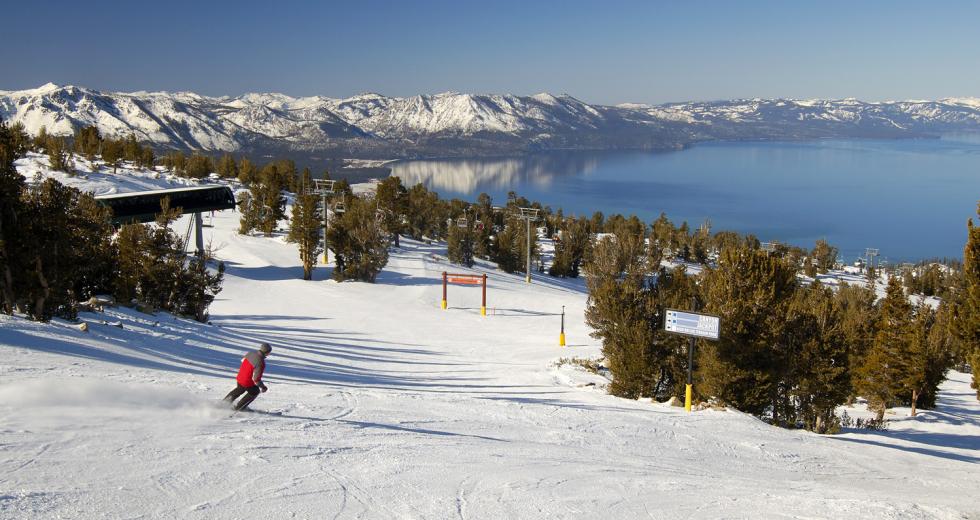Don’t have Fourth of July plans yet? How about a ski weekend … at Lake Tahoe?
That’s what Andy Wirth, CEO of Squaw Valley, is proposing after an historically snowy winter that surpassed 700 inches of snowfall this week. He’s so sure that this season’s snowfall will stick around, he’s hoping to stay open straight through the summer months and into the 2017-18 winter season.
“I’ll drop something on you that you may not be expecting,” Wirth told Truckee Tahoe Radio on April 15. “We are actually considering staying open through the summer and fall so it becomes the ’16-17-18 season. We’re taking a hard look at that. Maybe we spin Shirley [a lift on the mountain’s back side] through the summer, ’cause there’s so much snow up there.”
Defying the Odds
Mike Pierce, president of Ski Lake Tahoe, and Jon Erdman, senior digital meteorologist at the Weather Co., both agreed that August skiing at Squaw is perfectly viable.
“Squaw has always been an industry leader,” Pierce says, who mentioned that the mountains in Tahoe close “when demand wanes” rather than when snow melts. “We’ve had long seasons where people ski well into May. This year not only are we going into May, we’re going into May with huge, 30-foot bases,” he explains in a phone call from his office in Tahoe. “The views outside right now, they’re just like what you’d have seen in January.”
The 700 inches of snow this year is 250 inches above average, and January set a record for the mountain’s snowiest month ever. But how long will that deep, frozen base last?
Erdman says July 4 is a no-brainer. Staying open through August, though, is a bit far-fetched but “conceivable,” he says. “Our latest summer outlooks expect a hot summer in California eventually, especially as we get towards July and August.” But with low temperatures sticking to the 40s even in peak summer months, Pierce is confident that good grooming on the north side of the mountain will preserve and extend snow conditions, keeping some of the runs in good shape until snowmaking season kicks off again in the fall.
The Summer Ski Experience
“Tahoe really is the place where you can waterski and snow ski in the same day,” Pierce says. “Maybe this year you’ll golf and ski in the same day.”
Regardless, you’ll want to stick to morning runs — when the slopes are groomed and before the corduroy “corns up,” or turns into kernel-size nuggets. Or embrace it, if that’s your style. “Some people really like skiing corn,” Pierce says. “It’s actually a lot of fun, it carves nicely.”
By the time you’re ready for an après-ski rendezvous, the mountain comes to life with outdoor grilling, live music, and pond skims that feature costumed skiers performing tricks as they jump across man-made, mid-mountain lakes.
“We’ll have to turn the mountain into a beach,” Pierce says. “We know we’re competing with lots of other interests, and people are so ready for summer. So we create a real festival atmosphere to draw them in.”
Plus, there’s one big advantage you may not have considered: great tanning. “Snow reflects better than anything!” Pierce jokes. He speculated that Squaw may finally break Sochi’s long-held record for most bikini-clad skiers on a mountain.
The Bigger Picture
Skiing on the Fourth of July has been done in Squaw before, but only as a single-day stunt. Even Wirth, the resort’s CEO, calls this climate “incredible and unprecedented” on a scale that was being taken from “historic to biblical.”
Erdman attributes the weather to climate change, which is creating more extreme and frequent shifts from drought to flood and vice versa. “It puts a lot of stress on water managers, both in public government and private industry,” he says. If the snow melts gradually, the water will continue to replenish reservoirs that were deeply in need of refilling. If a hot streak melts it too quickly, though, some of that runoff may create flooding or spillover — not ideal.
For now, the extra snow is being hailed as a boon across the board. Erdman says, “To have the meltwater from all that snow recharge those reservoirs is spectacular news — about as good a scenario as you can get, for both skiers and also folks who are worried about their water supply.”



